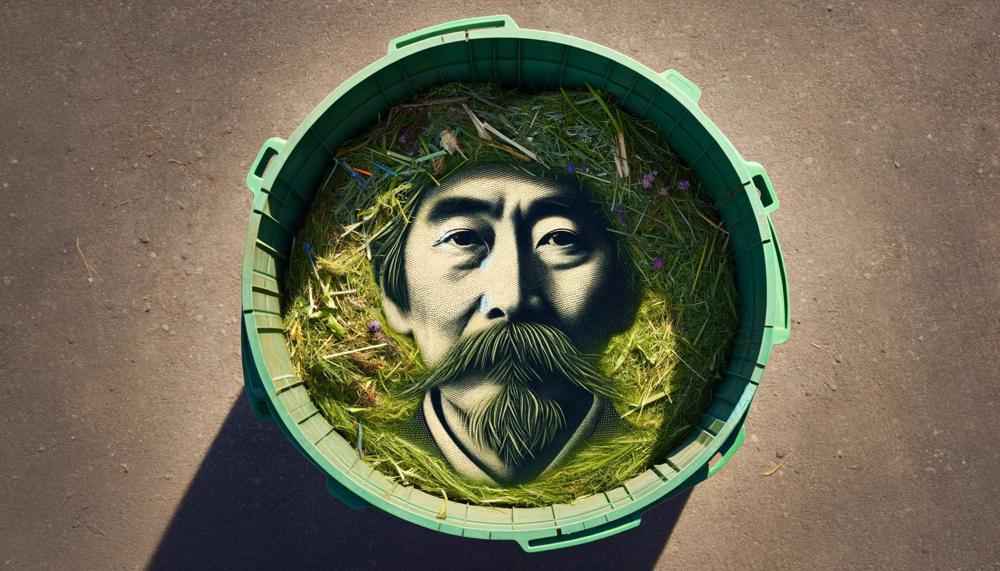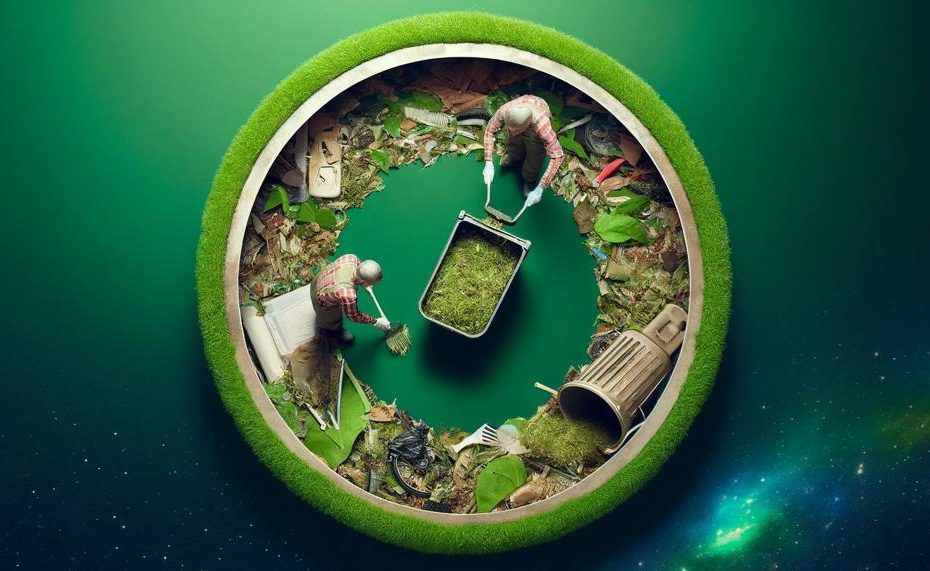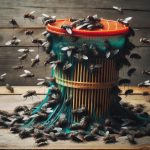People often think of grass cuttings as just yard waste because they are so common on our lawns. Throwing them away isn’t just a chore, though; it’s also a chance to do something good for our fields and the earth.
In our in-depth guide, where we’ll talk about creative and eco-friendly ways to deal with these green wastes.
Our exploration will unravel:
- The hidden benefits of grass clippings you’ve likely overlooked.
- Simple yet effective techniques to transform clippings into garden gold.
- Innovative practices for reducing waste and promoting sustainability.
We aim to bridge the gap between routine garden maintenance and environmental stewardship, providing you with actionable insights.
Whether you’re a seasoned gardener or a green-thumbed novice, our guide promises to equip you with knowledge and inspiration to turn what was once considered waste into a valuable resource for your garden and the planet.
Let’s embark on this green journey together, rethinking how we view and handle the aftermath of a freshly mowed lawn.
Contents
- 1 How to Dispose of Grass Clippings
- 2 Leaving Grass Clippings on The Lawn
- 3 Mulching With Grass Clippings
- 4 Grass Clippings Composting
- 5 Nitrogen-Rich Fertilizer with Grass Clippings
- 6 Grass Clippings Animal Feed
- 7 Lasagna Garden with Grass Clippings
- 8 Utilize Yard Waste Collection Services
- 9 Deposit Your Grass Clippings at The Local Disposal Site
How to Dispose of Grass Clippings
Disposing of grass clippings in an environmentally-friendly manner not only benefits your garden but also contributes positively to the ecosystem.
| Method | Benefits | How to Implement |
| Grasscycling | Reduces waste, enhances soil health | Mow regularly with sharp blades; don’t cut more than 1/3 of the blade height |
| Composting | Produces valuable soil conditioner | Balance green (clippings) with brown (dry leaves) materials in compost |
| Mulching | Conserves moisture, controls weeds | Spread dry clippings thinly over soil |
| Local Facilities | Supports community composting efforts | Contact local waste management for guidelines |
Leaving Grass Clippings on The Lawn
Leaving grass clippings on the lawn, often referred to as “grasscycling,” is a splendid way to nourish your garden naturally while saving time and resources. Below, we delve into the benefits of this practice and offer guidance on how to do it correctly.
Benefits of Grasscycling
- Natural Fertilization: Grass clippings decompose and return valuable nutrients, such as nitrogen, potassium, and phosphorus, back to the soil, reducing the need for synthetic fertilizers.
- Moisture Retention: They help the soil retain moisture, thereby reducing the need for watering.
- Weed Suppression: When used as mulch, clippings can suppress weed growth by blocking sunlight.
- Cost and Time Efficiency: Saves on the cost of yard waste bags and the time taken for bagging and disposal.
Proper Technique for Leaving Grass Clippings on the Lawn
| Action | Reason | Outcome |
| Mow when dry | Wet grass clumps, hindering even distribution | Evenly spread clippings that decompose quickly |
| Do not cut more than one-third of the grass blade | Prevents stress and promotes healthy growth | A lush and vibrant lawn |
| Use a mulching mower | Finely chops the clippings, facilitating faster decomposition | Nutrients return to the soil more efficiently |
To ensure the best outcomes, avoid leaving clumps of grass on the lawn as they can smother the grass beneath and cause yellow patches. If you find clumps after mowing, simply spread them out or rake them gently.
Remember, if your lawn has been treated with pesticides or herbicides, it’s wise to wait for a couple of mowings before starting to grasscycle, ensuring these chemicals do not harm your garden or local ecosystem.
Mulching With Grass Clippings
Mulching with grass clippings offers a simple, yet profoundly effective way to nurture your garden, providing a slew of benefits ranging from moisture retention to weed control. When done rightly, it stands as a testament to gardening savvy, turning the routine task of mowing your lawn into an opportunity to enrich your soil, making every blade of grass count.
Benefits of Using Grass Clippings as Mulch
Grass clippings, when used as mulch, act as a natural blanket for soil. They help in:
| Benefit | Method | Consideration |
| Moisture Retention | Spread thinly over soil | Avoid wet clumps to prevent mould |
| Weed Control | Layer around plants | Use untreated grass only |
| Cost-Effective | Direct application to garden | Monitor for signs of thatch |
By embracing the practice of mulching with grass clippings, you’re not just disposing of yard waste; you’re investing in the health and fertility of your garden.
Grass Clippings Composting
Grass clippings can transform a garden in more ways than one. Beyond just being remnants of a lawn care day, these green snippets have the power to enrich your compost heap, making your garden thrive like never before.
| Step | Action | Why It’s Important |
| Mix Your Greens and Browns | Combine grass clippings with dry leaves or other ‘brown’ materials. | It creates the perfect balance of nitrogen and carbon for composting. |
| Keep It Moist | Ensure the pile is as damp as a wrung-out sponge. | Moisture is crucial for the decomposition process. |
| Aerate Regularly | Turn your pile every few weeks to introduce oxygen. | Oxygen speeds up decomposition, preventing odour and pests. |
| Size Matters | Build your pile at least 4 feet high and wide. | A larger heap retains heat better, speeding up the composting process. |
| Accelerate Wisely | Add topsoil, manure, or meal to give the process a boost. | These additions introduce microorganisms that break down organic material faster. |
Nitrogen-Rich Fertilizer with Grass Clippings

Grass clippings are not just lawn waste; they’re a treasure trove of nitrogen, perfect for enriching your garden and lawn. Let’s delve into how these green gems can boost your green spaces.
| Method | Benefits | Considerations |
| Grasscycling | Boosts soil nitrogen, retains moisture | Avoid on wet grass to prevent clumping |
| Mulching | Suppresses weeds, adds nutrients | Don’t let clippings touch plant stems |
| Composting | Creates rich soil amendment | Mix with other organics for balance |
Grass Clippings Animal Feed
Grass clippings, often overlooked, hold a treasure trove of benefits both as animal feed and for eco-friendly disposal. Here’s how to tap into this green goldmine.
Grass Clippings as Animal Feed
- Rabbits and Livestock: Grass clippings can serve as a nutritious snack for rabbits and some livestock, intertwining comfort with sustenance when used as bedding.
- Worm Bins: For those running a worm bin, clippings are akin to a feast, supporting worm health and promoting rich compost production.
It’s not just about dumping clippings into pens, though. A touch of care ensures these green snippets provide maximum benefit without harm. Freshness is key; wilted or treated clippings could spell trouble, potentially harbouring toxins or losing nutritional value.
Proper Disposal Methods Post-Use
Once their role as feed or bedding concludes, the journey of grass clippings need not end. Here’s how to bid them farewell responsibly:
| Method | Process | Tips |
| Composting | Add to compost bins | Turn regularly, ensure balance with brown material |
| Liquid Fertilizer | Steep in water for a nutrient-rich tea | Use sparingly to avoid nutrient overload |
| Mulching | Spread around plants | Dry clippings preferable, layer thinly |
| Weed Prevention | Rake into unwanted growth areas | Prevents sunlight, deters weed germination |
Disposal mirrors the circle of life in a garden, with clippings contributing back to the soil’s vitality. Whether rejuvenating your compost pile or protecting your green sanctuaries from weeds, each clipping has a part to play.
Remember, though: moderation is the watchword. Just as with any delicacy, overindulgence, in this case in the form of excessive layering or unbalanced composting, can upset the natural order, turning a boon into a bane.
Lasagna Garden with Grass Clippings
Lasagna gardening, a clever approach to enriching soil, stands as an ideal method for disposing of grass clippings. This method layers organic materials to create a rich, nutritious bed for your plants, with grass clippings playing a crucial role.
Step-by-Step Guide to Using Grass Clippings in a Lasagna Garden
| Layer | Material | Function |
| 1 | Cardboard/Newspaper | Suppresses weeds, attracts worms |
| 2 | Compost/Manure | Adds nutrients |
| 3 | Straw | Provides structure |
| 4 | Grass Clippings | Adds nitrogen |
Why Grass Clippings are Gold
Grass clippings are a treasure in the garden. They decompose quickly, releasing nitrogen and other nutrients back into the soil, which enhances plant growth. They keep the pile moist and help to heat the compost, speeding up the decomposition process of other materials.
Tips for Optimal Results
- Balance is key: Ensure a good mix of green (nitrogen-rich) and brown (carbon-rich) materials to avoid a smelly, anaerobic pile.
- Keep it airy: Don’t compact the layers too much; oxygen is vital for the composting process.
- Moisture matters: The pile should be as wet as a wrung-out sponge to foster the right conditions for decomposition.
Utilize Yard Waste Collection Services
Yard waste collection services provide an efficient and eco-friendly method for disposing of grass clippings. Here are some key benefits:
| Benefit | Description | Impact |
| Environmental Preservation | Reduces greenhouse gas emissions | Contributes to a healthier planet |
| Nutrient Recycling | Transforms waste into valuable compost/mulch | Enhances soil health and productivity |
| Legal Compliance | Ensures adherence to local yard waste regulations | Avoids legal issues and fines |
| Convenience | Eliminates personal handling and transport of waste | Saves time and reduces physical effort |
| Safety | Minimizes the risk of injuries related to yard waste disposal | Ensures a safer home environment |
Utilizing yard waste collection services is not just a matter of tidying up; it’s about embracing a sustainable lifestyle that respects our environment and simplifies our daily routines.
Deposit Your Grass Clippings at The Local Disposal Site
Depositing your grass clippings at a local disposal site instead of just leaving them scattered across your lawn might seem like a bit of a palaver, but it’s a game-changer for both your green patch and the environment.
Here’s the lowdown on why it’s a smart move:
| Benefit | Explanation | Impact |
| Enhances Soil Health | Grass clippings, when properly processed, can be turned into compost, enriching the soil with nutrients. | Improves soil fertility without synthetic additives. |
| Reduces Waste | By depositing clippings, you’re contributing to the recycling of organic material, reducing landfill waste. | Lessens environmental footprint by minimizing methane emissions from decomposing organic matter in landfills. |
| Prevents Lawn Problems | Heavy layers of clippings left on the lawn can smother grass, block light, and foster disease. | Ensures healthier, more resilient turf. |
| Legal Compliance | Some localities have restrictions on yard waste disposal in landfills, making proper disposal necessary. | Avoids potential fines and supports municipal waste management strategies. |
| Supports Community Composting | Disposal sites often contribute to community composting programs, turning your waste into a resource. | Contributes to a circular economy, promoting sustainability. |
Here’s the skinny: Tossing your grass trimmings at a designated spot isn’t just about ticking a box for chores done. It’s a savvy move that boosts your soil’s mojo, keeps your lawn from throwing a fit, and plays nice with Mother Nature.
Plus, it’s a solid step towards keeping your digs in line with the law and backing community efforts to turn waste into gold.





